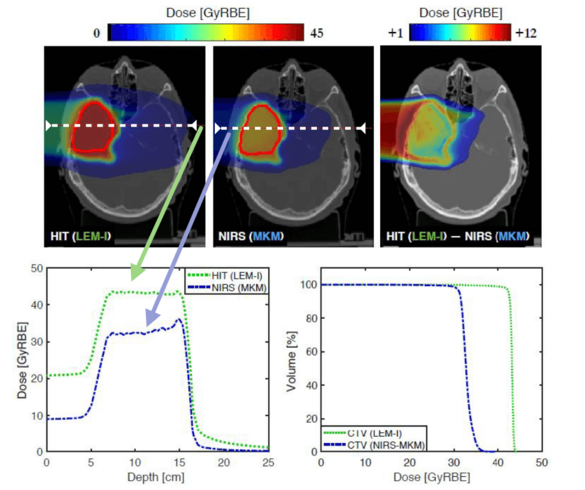2. Monte Carlo methods for research and clinical investigations
BioPT supports clinical activity at HIT using full Monte Carlo (MC) methods. When physicians encounter challenging clinical cases, the treatment plan must be verified against MC prediction to determine whether the plan can be deemed acceptable or requires undergo further optimization. MC methods are also applied during base data generation (both physical and biological parameters) when installing or updating the clinical TPS e.g. Syngo® RT Planning (Siemens, Erlangen, Germany) and RayStation® (RaySearch, Stockholm, Sweden).
At HIT, the FLUKA MC code has been developed and integrated as a clinical and research platform to most accurately describe the interaction and the transport of ion beams in matter. Novel nuclear models have been introduced improving the soundness of the mixed field description. Recently developed user-friendly interfaces ease the distribution of the MC-based tools to clinical environments. Monte Carlo related activities can be described in three distinct points:
- I. Clinical support: generation of the facility-specific base data using MC methods (depth-dose distributions, lateral dose distributions, fragment spectra) and verification/validation/ commissioning of the clinical TPS against MC prediction.
- II. Development of unique MC-based treatment planning (MCTP) tools to provide advanced treatment planning optimization solutions (for both physical and biological dose) in cases where results from the clinical TPS (analytical algorithm) is inadequate. With such platforms, the impact of the various biological perspective on clinical outcome, which is urgently needed, can be assessed (Fig. 1).
- III. Characterization of novel ion beams (helium- and oxygen- ions) in terms of physical dose and biological dose distributions while introducing innovative relative biological effectiveness (RBE) models for light ion therapy.
Through these efforts, accurate calculation methods for CPT has been established and integrated at several hospital-based hadron therapy facilities in Europe. Using these methods, over 7000 patients have been treated to-date with proton and carbon ion beams in Europe, with numerous pre-clinical studies performed or currently active for novel ion beam modalities.

Literature:
A. Mairani et al., “A Monte Carlo-based treatment planning tool for proton therapy.,” Phys. Med. Biol., vol. 58, no. 8, pp. 2471–90, 2013
T. T. Böhlen et al., “A Monte Carlo-based treatment-planning tool for ion beam therapy,” J. Radiat. Res., vol. 54, no. SUPPL.1, 2013.
J. Bauer et al., “Integration and evaluation of automated Monte Carlo simulations in the clinical practice of scanned proton and carbon ion beam therapy,” Phys. Med. Biol., vol. 59, no. 16, pp. 4635–4659, 2014.
T. Tessonnier et al., “Dosimetric verification in water of a Monte Carlo treatment planning tool for proton, helium, carbon and oxygen ion beams at the Heidelberg Ion Beam Therapy Center,” Phys. Med. Biol., vol. 62, no. 16, pp. 6579–6594, 2017.






